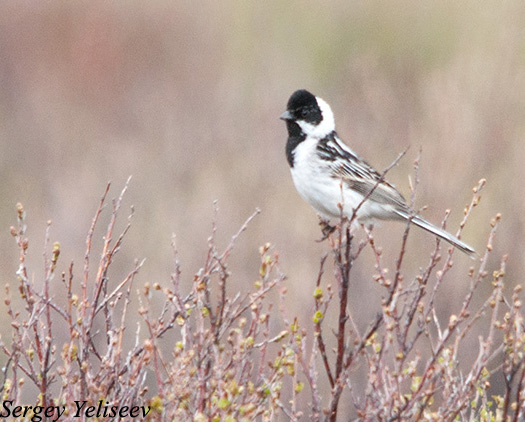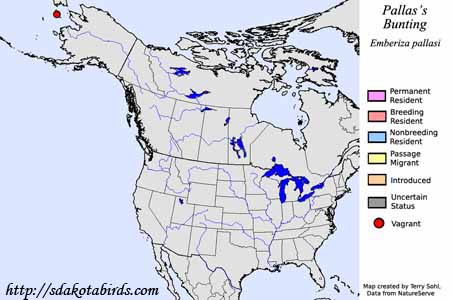| Length: 5.5 inches | Wingspan: 9 inches | Seasonality: Non-resident in South Dakota |
| ID Keys: Male with black head and throat, white underparts, collar, and back of head, and streaked upperparts | ||
 The
Palla's Bunting is normally an Asian bird, breeding in northern Asia and
moving to southeastern Asia for the winter. In North America, they are
known from a handful of sightings near Gambell, Alaska, on St. Lawrence
Island, or more rarely, on the mainland of western Alaska. They are
also sometimes referred to as Pallas's Reed Bunting.
The
Palla's Bunting is normally an Asian bird, breeding in northern Asia and
moving to southeastern Asia for the winter. In North America, they are
known from a handful of sightings near Gambell, Alaska, on St. Lawrence
Island, or more rarely, on the mainland of western Alaska. They are
also sometimes referred to as Pallas's Reed Bunting.
Habitat: During the summer breeding season, Pallas's Buntings are found in shrubby tundra areas, usually near water. In migration and in winter, they can be found in similar shrubby areas, but they will also use grasslands and other habitats.
Diet: Feeds heavily on seeds, but during the breeding season they will also feed on insects and other small invertebrates.
Behavior: Mostly forages on the ground or low in vegetation.
Nesting: The nest is a cup of moss and grasses, placed low in a bush or on the ground. The female lays between 3 and 6 eggs, and she does most of the incubation. Once the eggs hatch, both parents help to feed and raise the young.
Song: A soft musical trilling
Migration: Migratory, with most birds breeding in Russia, and moving to southeastern Asia for the winter.
Feeders: Has attended feeders for millet and other commonly offered seeds.
Interactive eBird map: Click here to access an interactive eBird map of Pallas's Bunting sightings
Similar Species: Male distinctive if seen well, although general head pattern may suggest Reed Bunting (another Old World species rarely found in North America).
Conservation Status: Populations are strong and stable, and they are found over a wide geographic area. The IUCN lists the Palla's Bunting as a species of "Least Concern".
Further Information: 1) BirdLife International - Pallas's Bunting
2) WhatBird - Pallas's Bunting
3) BirdGuides - Pallas's Bunting
Photo Information: Photo by Sergey Yeliseev - June 5th, 2012 - Republic of Altai, Russia - Photo licensed under Creative Commons Attribution NonCommercial NoDerivs 2.0 Generic License.
| Click below for a higher-resolution map |
 |
| South Dakota Status: Non-resident in South Dakota |
Additional Pallas's Bunting Photos (coming soon!!)
